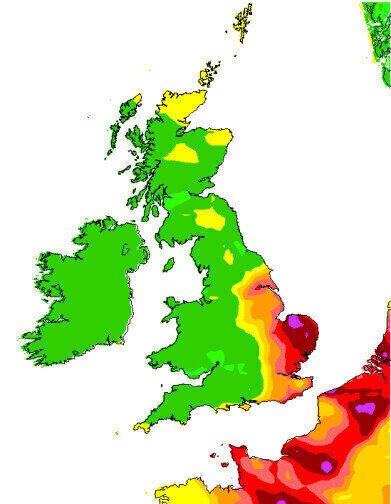Air Monitoring
What Is an Air Pollution Forecast?
Oct 27 2014
An air pollution forecast provides information on air quality and the impact of pollutants on human health. There are trace amounts of gases and particles in the air that we breathe which can be harmful to health. Industrial processes and the combustion of fossil fuels cause pollutants such as sulphur dioxide, nitrogen oxides and particulate matter to be released into the atmosphere. These three primary pollutants can then chemically interact to produce secondary pollutants such as ozone.
The Met Office produces the Department for Environment Food and Rural Affairs’ (DEFRA) air pollution forecasts for the UK, which are based on a standard index to characterise air quality, the Daily Air Quality Index (DAQI). The DAQI is a simple 10-point scale which uses a combination of numbers, words and colours to describe the expected levels of pollution. Other less common pollutants can degrade air quality, such as the accidental release of a harmful chemical; however, this type of pollutant is not included on the routine forecast. The DAQI also associates each pollution level with particular health information, both for the general public and those who are more sensitive to air pollution.
Forecasts are valid from midnight through to midnight. While forecasts for longer time periods are less reliable, as are weather forecasts, they still provide a good overview of future trends. In this recent article, Making Decisions for the Ever Changing Weather, Rob Harrison looks at the UK climate to explain why it can be so varied – and how technology at the Met Office is helping the commercial world to use weather forecasts to manage risks, plan operations and ensure health and safety.
It is possible to obtain air pollution forecasts for over 5,000 specific urban and rural background locations in the UK. However, these may be less accurate close to busy roads where pollution is likely to be higher.
How are forecasts produced?
The accumulation of pollution levels in the atmosphere depends on four factors: the emission of pollutants, the distribution of pollutants by winds, the removal of pollutants by elements such as rain, and chemical reactions between gases and aerosols.
The weather forecast and climate prediction model has been set up to include these four processes. This model simulates the release of chemical species into the atmosphere using both UK and European maps of annual average pollutant emissions, which are then able to chemically react according to prescribed rates, differing according to temperature, amount of sunlight and concentration of the species. Species are also dispersed by winds within the model, and levels are recalculated accordingly. From this information, it’s possible to calculate the DAQI as an average over specific time periods.
The forecast is made more accurate by incorporating recent observations from the Automatic Urban and Rural Network (AURN), which has air pollution quality observation sites around the UK that provide hourly measurements of pollutant emissions. The Met Office uses this information to measure their forecast against, which allows them to regularly monitor the performance of forecasts and to investigate reasons for poor forecasting.
Digital Edition
IET 34.2 March 2024
April 2024
Gas Detection - Biogas batch fermentation system for laboratory use with automatic gas analysis in real time Water/Wastewater - Upcycling sensors for sustainable nature management - Prist...
View all digital editions
Events
Apr 30 2024 Melbourne, Australia
Apr 30 2024 Birmingham, UK
May 03 2024 Seoul, South Korea
May 05 2024 Seville, Spain
May 06 2024 Minneapolis, MN, USA


















